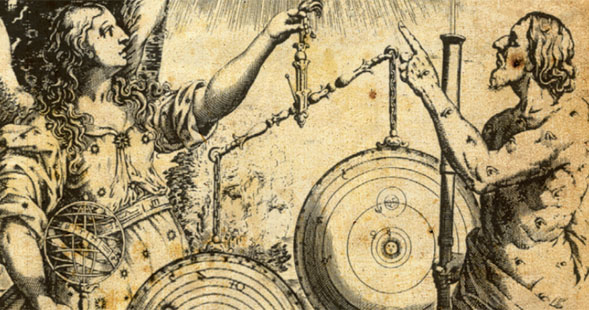Astronomy, Art, Religion Explored
A new Special Collections exhibit features rare astronomical works.

Special Collections announced the opening of a new exhibit Heavenly Revolutions: The Dawn of Our Solar System.
The exhibit features rare astronomical works from the world-class Ernst Zinner Historic Astronomy Collection held in Special Collections. On display are original works by many of the most important astronomers in history, including:
- Sacro Bosco
- Nicolai Copernicus
- Tycho Brahe
- Johannes Kepler
- Galileo
- Isaac Newton
"The exhibit 'Heavenly Revolutions: The Dawn of Our Solar System' includes a number of fundamental works in astronomy," said emeritus astronomy professor F.D. Talbert. "It is inspirational to an astronomer, and to astronomy students, to be able to see the original volumes that have played pivotal roles in changing our world view."
Where displayed
The exhibit will be on display in the Louis Kenney Reading Room (LA4410) through December 2012.
Exhibit themes
Heavenly Revolutions explores a central theme in the history of astronomy, namely the earth's place within the larger universe. Starting with the Greco-Roman astronomer Ptolemy, the exhibit presents the geocentric theory persisting until the seventeenth century that the earth was fixed at the center of space.
Following is the heliocentric theory that the earth and other planets revolve around a fixed sun. The new sun-centered theory appeared with the 1543 printing of Nicolai Copernicus' De Revolutionibus Orbium Caelestium (On the Revolution of the Heavens), perhaps the greatest work in the history of astronomy and one that helped establish modern science.
The exhibit features a first edition of De Revolutionibus, complete with Papal marginalia, and a second edition printed in 1566. The Copernican revolution, that the earth and therefore humanity are not at the center of the universe, challenged and threatened ancient and contemporary astronomical theories, as well as worldviews and commonly held religious and cultural beliefs.
Other works on display by Tycho Brahe, Johannes Kepler, Galileo, and Isaac Newton all either built on, refined, or reworked the Copernican theory, thus laying the foundation for today’s explanation of the solar system.
Heavenly Revolutions was researched, designed, and beautifully constructed by Amanda Lanthorne and Anna Culbertson, with assistance from Emeritus Astronomy Professor Fred Talbert and graphic design student assistant D.J. Bradley.



